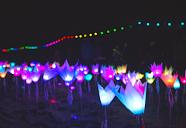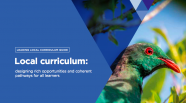Local curriculum in technology using a light festival
LUMA light festival participation
LUMA, an annual Queenstown light festival, provides an authentic context for local curriculum in technology.
The local secondary school and primary schools take part in installations each year. The festival provides opportunities for the students to develop technological practice and technological knowledge.
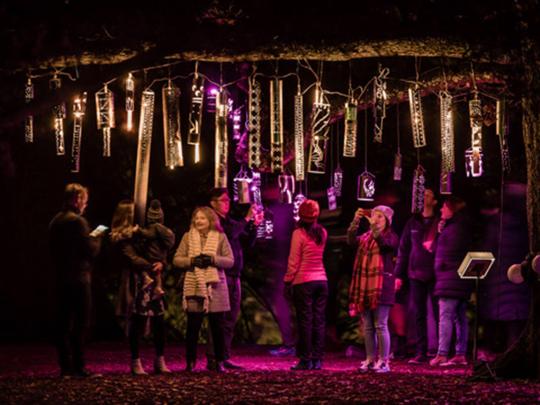
Image by Aiste Photography, courtesy of LUMA Southern Light Project
Getting started
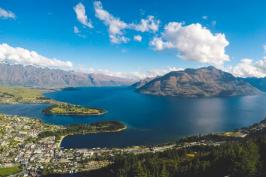 Community links – local curriculum
Community links – local curriculum

Rebecca Lund is the technology workshop teacher at Wakatipu High School. She became the festival's schools’ coordinator in its second year and offered workshops to Queenstown primary schools. Rebecca taught teachers and students construction skills for the schools’ installation. She made suggestions for curriculum links. The workshops engaged teachers and students in the project.
In subsequent years, primary schools collect a brief from Rebecca. Rebecca and the schools meet to discuss progress, outcomes, and stakeholder feedback.
Using the festival in class
Primary school
Remarkables Primary STEAM teacher Sarah Washbrooke develops a variety of programmes of learning around the festivals.
Sarah is a STEAM advocate. She believes this approach acknowledges that technology draws on multiple disciplines. For example 3D printed sea creatures were developed during a school-wide health and wellbeing focus. See disciplinary knowledge under key ideas characteristics of technology.
Secondary school
Rebecca uses the festival installations for students to investigate:
- digital technologies
- design and stakeholder requirements
- materials outcomes.
The students gain skills and use multiple pieces of workshop equipment.
LUMA Festival
LUMA is a popular, Queenstown community, light festival first held in 2016. LUMA takes place on Queen’s Birthday weekend. It runs for four evenings of illuminated art sculptures and entertainment. LUMA has a particular theme each year. Sustainability is always part of the theme.
Electronic flowers
Community links – local curriculum
The Queenstown Gardens were 150 years old in the festival’s second year. Over 150 students from Wakatipu High School, Shotover Primary School, Queenstown Primary School, and Arrowtown Primary School manufactured 150 flowers to light up the garden beds.
Technology local curriculum
Students saw the electronics used in the flowers. They gained an all round understanding of the design process and modelling a prototype that was fit for purpose.
See key ideas characteristics of technology and key ideas outcome development and evaluation.
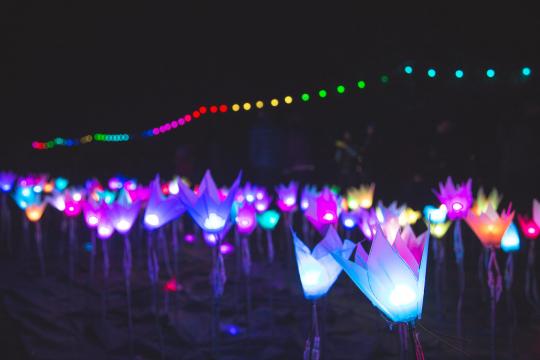
Image by Jonny James, Storyworks, courtesy of LUMA Southern Light Project
Luminescent 3D printed sea creatures
 Technology in a school-wide focus
Technology in a school-wide focus

In the festival’s second year Remarkables Primary students were working on an inquiry about bacteria – drawn from a school-wide focus on health and wellbeing.
Teacher Sarah’s research located Auckland University Bioluminescent Superbugs Lab scientists. The Bioluminescent Superbugs Lab focuses on using luminescent material to find and fight disease in the human body. The scientists visited the school and helped the students design and make 3D printed glow-in-the-dark sea creatures for the festival.
Using a 3D printer
The students learnt to use Tinkercad and a 3D printer to design and print sea creatures.
3D printing in plastic encouraged students to explore the impacts of plastic types on the environment. Glow-in-the-dark plastic or injected bioluminescent material made the creatures glow.
Students used accurate scale and measurement to make a hole in the correct position on the creature to produce a successful outcome.
Adding luminescence
Bioluminescent lab scientists brought the luminescent material made from snapper fish gut content. The material, injected into the shells, glowed when they moved.
The bioluminescent material was viable for 24 hours.
Recycled plastic jellyfish
Theme inspiration
Sustainability, reusing and recycling plastics within a sea theme of jellyfish was chosen in the festival's third year. The theme inspiration came from an image a student saw of turtles ingesting plastic bags they thought were jellyfish.
The installation alerted the audience to the ongoing issues around plastic sustainability and its effects on marine life and the ocean.
The installation involved Remarkables Primary and Shotover Primary students.
The brief
The designers asked the Remarkables Primary students to develop outcomes for the theme that:
- had visual impact
- would look aesthetically pleasing when hung 1-3 metres in the air
- had tentacles in which to hang LED lights.
Designing to the brief
Groups of students created many design iterations. The stakeholders provided ongoing feedback before approving a final design. Stakeholders were the schools’ coordinator Rebecca, electricians, the festival designers, and Shotover Primary.
Developing the brief
The students and stakeholders agreed to specification constraints as the brief developed. Students needed to use a paper lantern base and a spherical, elliptical shape.
Students could change the shape by overlaying with translucent material. They could create their own design for the tentacles but use translucent material.
Creating the jellyfish
Translucent binding, strapping, ribbon, and packaging beads were sourced at no cost from local businesses. The students experimented with different types of LED lights in their jellyfish.
Technology local curriculum
The students learnt about brief development – specification constraints and stakeholder feedback.
A focus on materials (technological products) included testing and trialling materials and recycling materials. Students explored material properties like what performance properties – translucent, transparent, or opaque – were the most effective for their designs.
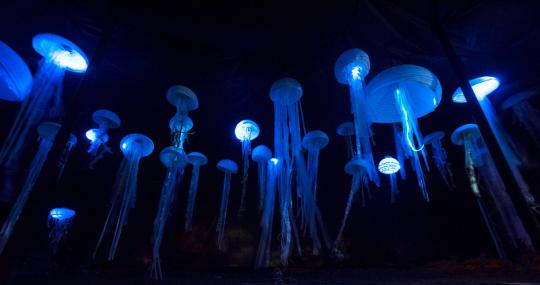
Image by Simon Holden, courtesy of LUMA Southern Light Project
UV painted extinct bird silhouettes
Community links – local curriculum
In the festival’s third year Wakatipu High School year 9 students created life-size silhouettes of many of New Zealand’s extinct birds. The creations included a bush moa, Haast's eagle pouākai, and Finsch’s duck.
The students outlined their shapes and painted patterns using UV paint. The UV paint showed up under black light.
After the festival the Otago Peninsula Trust asked Rebecca and the students if they would contribute to the Glenfalloch Night Garden with silhouettes to support their albatross colony work.
Technology learning area
The students explored brief development and developed skills to create the birds.
They worked with feedback to meet stakeholder requirements.
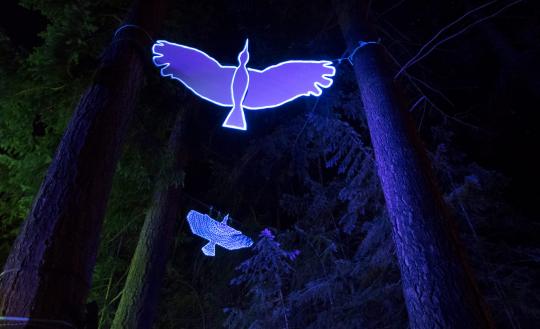
Image by Simon Holden, courtesy of LUMA Southern Light Project
Lanterns from pipe offcuts
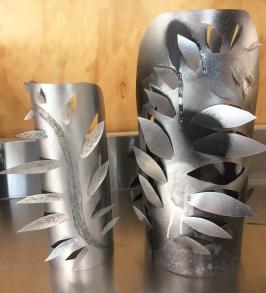 The brief
The brief

In year four the primary and secondary schools worked together. The installation included work from Queenstown primary schools, and year 9 work from Wakatipu High School. The LUMA festival directors made the sustainability theme more demanding. The outcomes had to:
- be lanterns from a plastic pipe offcut from a building project
- be eye-catching and interesting (aesthetically pleasing)
- incorporate a geometric shape and pattern
- be able to be developed into another product for LUMA next year – they asked the students to think of it as a two or three year project
- be able to fit lighting inside
- be completed and ready to install by a set date.
The festival directors wanted the public to work the lighting effects rather than passively wandering through the installation. Students learnt about the different lighting types available for the display. The lights connected to sound and motion sensors or required switches to be located and turned on.
Communicating with stakeholders
Year 6 students
Remarkables Primary students asked questions of stakeholder Rebecca to refine their designs.
A new garden meant the lanterns needed to hang in a tree. Students learnt about adjusting designs to match stakeholder changing needs.
Year 9 students
The festival designers came into school every six weeks or provided feedback via Rebecca.
Feedback included congratulating the students on original ideas the festival designers hadn’t considered, and discarding ideas that didn’t fit with the festival vision, or wouldn’t work in the festival setting.
The project provided an effective, authentic learning opportunity for students about designing and creating to meet stakeholders requirements.
Designing to the brief
Year 6 students
Remarkables Primary students looked at patterns and thought about symmetry, fractals, and measurement. Tube patterns explored included shapes:
- linked to the environment such as leaves
- linked to the LUMA festival
- that were geometric
- reflective of a particular culture.
Year 9 students
The students designed ideas to meet the brief. They voted to select the best idea to share with the festival designers.
Rebecca provided opportunities for skill building. These included how to measure accurately and use multiple pieces of workshop equipment. Equipment used included the bandsaw, scroll saw, files, and the drill press.
Festival lanterns
Ten year 9 students worked alongside the designers and electricians installing the lanterns.
See the recycled lanterns being installed in this LUMA video.
See the lanterns in the festival in this TVNZ news clip.
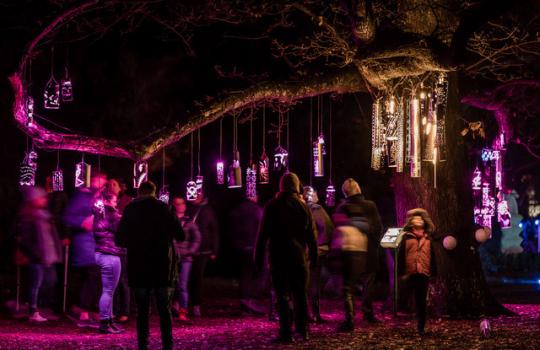
Image by Aiste Photography, courtesy of LUMA Southern Light Project
Further technology local curriculum links
Primary school
In year two the Remarkables Primary art teacher with year 1 and year 2 students made glow-in-the-dark sea creatures. They used clay and fluorescent paint. This outcome had an art focus but STEAM teacher Sarah says there are links to the technology learning area in the materials technological area – technological products, and technological practice.
Secondary school
In year two the Wakatipu High School art department created clay houses. Media studies students designed music to go with lighting systems. The lighting and sound systems could be explored as a technological system.
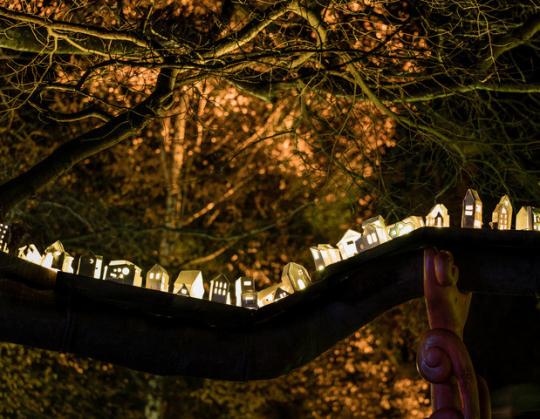
Image by Aiste Photography, courtesy of LUMA Southern Light Project
Jellyfish soundscape
In year three festival directors wanted a soundscape to accompany the primary school jellyfish installation. Wakatipu High School year 13 media studies students were given the brief.
The festival directors chose a student’s water soundscape. Regular meetings with a director gave the student feedback on how to develop and refine his creation.
The soundscape incorporated underwater sounds such as turtles eating coral, boat engines, and bubbles.
The project could be used to develop understandings within the designing and developing digital outcomes of the technology learning area.
You might also like ...
Leading Local Curriculum Guide series
This guide series has been developed to deliberately steer your curriculum and assessment review and design decisions as you strengthen your local curriculum.

